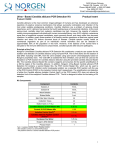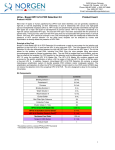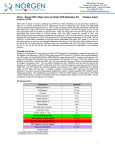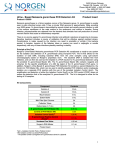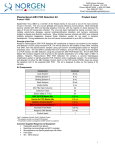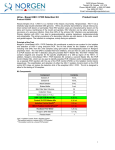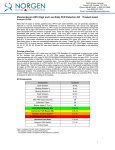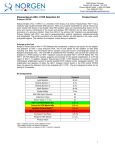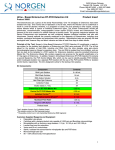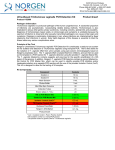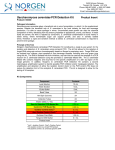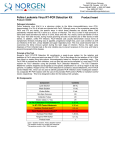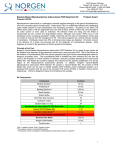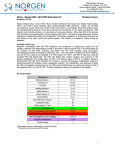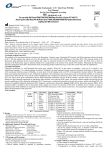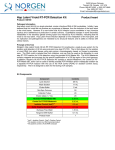Download Urine-Based Chlamydia PCR Detection Kit
Transcript
3430 Schmon Parkway Thorold, ON, Canada L2V 4Y6 Phone: 866-667-4362 • (905) 227-8848 Fax: (905) 227-1061 Email: [email protected] Urine - Based Chlamydia PCR Detection Kit Product Insert Product # 31400 Chlamydia trachomatis, the causative agent of Chlamydia, is a Gram negative bacteria. Transmission of the bacteria occurs via contact with infected bodily fluids which then infect mucosal membranes. It can be transmitted from mother to child during pregnancy and infect the eyes causing conjunctivitis. The genital infection causes urethritis, epididymitis and prostatitis in males and Pelvic Inflammatory Disease (PID) in females with an increased risk of contracting HIV. The infection can be treated with a course of antibiotics. Sexually transmitted infections in females are most often asymptomatic, but can be noticeable in chronic pain of the pelvic region, vaginal bleeding and painful urination. Infection of the ovaries, fallopian tubes or uterus causes Pelvic Inflammatory Disease (PID) which can lead to difficulties in conceiving, increased risk of ectopic pregnancy or infertility. Infections in males are more likely to be symptomatic, causing painful urination, discharge from the penis and swollen testicles and may eventually causes infertility if left untreated. Principle of the Test Norgen’s Urine-Based Chlamydia PCR Detection Kit constituents a ready-to-use system for the isolation and detection of Chlamydia using end-point PCR. The kit first allows for the isolation of total DNA, including bacterial DNA, from the urine samples using spin-column chromatography based on Norgen’s proprietary resin. The bacterial DNA is isolated free from inhibitors, and can then be used as the template in a PCR reaction for Chlamydia detection using the provided Chlamydia Master Mix. The Chlamydia Master Mix contains reagents and enzymes for the specific amplification of a 260 bp region of the Chlamydia’s Cryptic plasmid. In addition, Norgen’s Urine-Based Chlamydia PCR Detection Kit contains a second Master Mix, the PCR Control Master Mix, which can be used to identify possible PCR inhibition and/or inadequate isolation via a separate PCR reaction with the use of the PCR Control (PCRC) or the Isolation Control (IsoC) respectively. The amplification and detection of either the Chlamydia Isolation Control (IsoC) or the PCR control (PC) does not reduce the detection limit of the analytical Chlamydia PCR. The kit is designed to allow for the testing of 24 samples. Kit Components: Component Contents Solution A 10 mL Solution B 15 mL Wash Solution 9 mL Elution Buffer 3 mL Mini Filter Spin Columns 24 Collection Tubes 24 Elution tubes (1.7 mL) 24 Chlamydia 2X PCR Master Mix 0.35 mL Control 2X PCR Master Mix 0.35 Isolation Control (IsoC)* a Chlamydia Positive Control (PosC)* 0.3 mL b 0.1 mL Nuclease-Free Water 1.25 mL Norgen’s DNA Marker 0.1 mL Product Insert 1 *IsoC = Isolateion Control; PosC= Positive Control a The isolation control is a cloned PCR product b The positive control is a fragment of Chlamydia cloned in a plasmid 1 Customer-Supplied Reagents and Equipment • Disposable powder-free gloves • Centrifuge with a swinging bucket rotor capable of 2000 RPM • Benchtop microcentrifuge • Micropipettors • Sterile pipette tips with filters • PCR tubes • Lysozyme • 96 – 100% ethanol • 60°C incubator • 15 mL tubes Storage Conditions and Product Stability All buffers should be kept tightly sealed and stored at room temperature (15-25oC) for up to 1 year without showing any reduction in performance. The Chlamydia 2X PCR Master Mix, Control 2X PCR Master Mix, Isolation Control (IsoC), and Chlamydia Positive Control (PosC) should be kept tightly sealed and stored at -20oC for up to 1 year without showing any reduction in performance. Repeated thawing and freezing (> 2 x) should be avoided, as this may reduce the sensitivity. If the reagents are to be used only intermittently, they should be frozen in aliquots. General Precautions The user should exercise the following precautions while using the kit: • Use sterile pipette tips with filters. • Store and extract positive material (specimens, controls and amplicons) separately from all other reagents and add it to the reaction mix in a spatially separated facility. • Thaw all components thoroughly at room temperature before starting an assay. • When thawed, mix the components and centrifuge briefly. • Work quickly on ice. Quality Control In accordance with Norgen’s ISO 9001 and ISO 13485-certified Quality Management System, each lot of Norgen’s Chlamydia 2X PCR Master Mix, Control 2X PCR Master Mix, Isolation Control (IsoC) and Chlamydia Positive Control (PosC) are tested against predetermined specifications to ensure consistent product quality. Product Use Limitations Norgen’s Urine-based Chlamydia PCR Detection Kit is designed for research purposes only. It is not intended for human or diagnostic use. Product Warranty and Satisfaction Guarantee NORGEN BIOTEK CORPORATION guarantees the performance of all products in the manner described in our product manual. The customer must determine the suitability of the product for its particular use. Safety Information This kit is designed for research purposes only. It is not intended for human or diagnostic use. The Lysis Solution contains guanidinium salts, and should be handled with care. Guanidinium salts form highly reactive compounds when combined with bleach, thus care must be taken to properly dispose of any of these solutions. Ensure that a suitable lab coat, disposable gloves and protective goggles are worn when working with chemicals. For more information, please consult the appropriate Material Safety Data Sheets (MSDSs). These are available as convenient PDF files online at www.norgenbiotek.com. 2 CAUTION: DO NOT add bleach or acidic solutions directly to the sample-preparati on waste. If liquid containing these buffers is spilled, clean with suitable laboratory detergent and water. If the spilled liquid contains potentially infectious agents, clean the affected area first with laboratory detergent and water, and then with 1% (v/v) sodium hypochlorite. 1. Protocol A. Specimen Collection, Storage and Transport Precaution: All samples have to be treated as potentially infectious material. A. Specimen Collection, Storage and Transport General Precautions • Follow universal precautions. All patient specimens should be considered as potentially infectious and handled accordingly. • Wear personal protective equipment, including gloves and lab coats when handling kit reagents. • Wash hands thoroughly when finished performing the test. • Do not smoke, drink or eat in areas where kit reagents and/or human specimens are being used. • Dispose of unused kit reagents and human specimens according to local, provincial or federal regulations. • Do not use supplies and equipment across the dedicated areas of specimen extraction and sample preparation. No cross-movement should be allowed between the different areas. • Personal protective equipment, such as laboratory coats and disposable gloves, should be area specific. • As contamination of patient specimens or reagents can produce erroneous results, it is essential to use aseptic techniques. • Pipette and handle reagents carefully to avoid mixing of the samples. • Use proper pipetting techniques and maintain the same pipetting pattern throughout the procedure to ensure optimal and reproducible values. • Do not substitute or mix reagents from different kit lots or from other manufacturers 1. Specimen Collection and Sample Storage • Midstream urine samples should be collected, as the first flow of urine has been shown to have a higher rate of contamination (Morimoto et al., 2003). • It is highly recommended that urine samples be collected using Norgen’s Urine Collection and Preservation Tubes (Cat# 18111). The urine samples can be stored for at least one year at room temperature when collected directly using Norgen’s Urine Collection and Preservation Tubes. • Alternatively, urine samples collected using any other collection and preservation systems or reagents are also compatible with this kit. 2. Sample Transport • Sample material should be transported in a shatterproof, leak-proof transport container as a matter of principle. Thus, a potential danger of infection due to a leakage of sample can be avoided. • The samples should be transported following the local and national instructions for the transport of pathogen material. 3 B. Isolation of DNA from Urine Notes: • Do not spin down or filter the urine sample before proceeding with the isolation, as this could negatively affect the isolation of Chlamydia DNA. • Ensure that all solutions are at room temperature prior to use, and that no precipitates have formed. If necessary, warm the solutions and mix well until the solutions become clear again. • Preheat an incubator or heating block to 60°C. • Prepare a working concentration of Wash Solution by adding 21 mL of 96-100% ethanol (provided by the user) to the supplied bottle containing the concentrated Wash Solution. This will give you a final volume of 30 mL. The label on the bottle has a box that may be checked to indicate that the ethanol has been added. • Prepare a 400 mg/mL stock solution (approximately 1.7 x107 units/mL) of lysozyme as per supplier's instructions. • Isolation Control (IsoC) • An Isolation Control (IsoC) is supplied. This allows the user to control the DNA isolation procedure. For this assay, add the Isolation Control (IsoC) as indicated during the isolation procedure • The Isolation Control (IsoC) must not be added to the sample material directly. • Do not freeze and thaw the Isolation Control (IsoC) more than 2 times. • The Isolation Control (IsoC) must be kept on ice at all times during the isolation procedure. • The PCR components of the Urine-Based Chlamydia PCR Detection Kit should remain at -20oC until DNA is extracted and ready for PCR amplification. • It is important to work quickly during this procedure. 1. Add 300 µL of Solution A to 10 mL urine sample. Mix well by vortexing for 10 seconds. (Note 1: Solution A must be mixed well before every pipetting) 2. Centrifuge for 5 minutes at 2,000 RPM, then discard the supernatant carefully in order not to dislodge the precipitated slurry pellet. 3. Add 20 µL of the previously prepared lysozyme to the precipitated slurry pellet. Vortex for 10 seconds. Incubate the mixture at 60°C for 20 minutes 4. Add 500 µL Solution B to the precipitated slurry pellet, mix well by vortexing for 10 seconds. 5. Add 10 µL Isolation Control (IsoC) to the mixture from Step 4. 6. Add 500 µL of 96-100% Ethanol to the mix from Step 5, mix well by vortexing for 10 seconds. 7. Transfer 650 µL from the previous mix into a Mini Filter Spin column and centrifuge for 1 minute at 14,000 RPM. Discard the flowthrough and reassemble the spin column with its collection tube. 8. Repeat Step 7 until the entire mixture from Step 6 has been transferred to the Mini Filter Spin Column. 9. Apply 400 µL of Wash Solution to the column and centrifuge for 1 minute. Discard the flowthrough and reassemble the spin column with its collection tube. 10. Repeat Step 9 to wash column second time. 11. Wash the column a third time by adding another 400 µL of Wash Solution to the column and centrifuge for 1 minute. Discard the flow-through and reassemble the spin column with its collection tube. 12. Spin the column for 2 minutes empty at 14,000 RPM in order to thoroughly dry the resin. Discard the collection tube. 13. Transfer the spin column to a fresh 1.7 mL Elution tube. Apply 100 µL of Elution Buffer to the column and centrifuge for 2 minutes at 2,000 RPM, followed by 1 minute at 14,000 RPM. 4 C. Chlamydia PCR Assay Preparation Notes: • Before use, suitable amounts of all PCR components should be completely thawed at room temperature, vortexed and centrifuged briefly. • The amount of Chlamydia 2X Detection PCR Master Mix and Control 2X PCR Master Mix provided is enough for up to 32 PCR reactions (24 sample PCR, 4 positive control PCR and 4 no template control PCR). • For each sample, one PCR reaction using the Chlamydia 2X Detection PCR Master Mix and one PCR reaction using Control 2X PCR Master Mix should be set up in order to have a proper interpretation of the results. • For every PCR run, one reaction containing Chlamydia Positive Control and one reaction as no template control must be included for proper interpretation of results. • The recommended minimum number of DNA samples tested per PCR run is 6. • Using a lower volume from the sample than recommended may affect the sensitivity of the Chlamydia Limit of Detection. 1. Prepare the PCR reaction for sample detection (Set #1, using Chlamydia 2X Detection PCR Mastermix) and the PCR reaction for control detection (Set #2, using Control 2X PCR Mastermix) as shown in Table 1 below. The recommended amount of sample DNA to be used is 2.5 μL. However, a volume between 1 and 5 μL of sample DNA may be used as template. Ensure that one Chlamydia detection reaction and one control reaction is prepared for each DNA sample. Adjust the final volume of the PCR reaction to 20 μL using the Nuclease-Free Water provided. Table 1. PCR Assay Preparation PCR Components Volume Per PCR Reaction Chlamydia 2X PCR Master Mix OR Control 2X PCR Master Mix Sample DNA 2.5 µL Nuclease-Free Water 7.5 µL Total Volume 20 µL 10 µL 2. For each PCR set, prepare one positive control PCR as shown in Table 2 below: Table 2. PCR Positive Control Preparation PCR Components Volume Per PCR Reaction Chlamydia 2X PCR Master Mix OR Control 2X PCR Master Mix 10 µL Chlamydia Positive Control (PosC) 10 µL Total Volume 20 µL 5 3. For each PCR set, prepare one no template control PCR as shown in Table 3 below: Table 3. PCR Negative Control Preparation PCR Components Volume Per PCR Reaction Chlamydia 2X PCR Master Mix OR Control 2X PCR Master Mix 10 µL Nuclease-Free Water 10 µL Total Volume 20 µL D. Chlamydia PCR Assay Programming 1. Program the thermocylcer according to the program shown in Table 4 below. 2. Run one step PCR. Table 4. Chlamydia Assay Program PCR Cycle Step Temperature Duration Step 1 o 95 C 3 min Step 1 o 94 C 15 sec Step 2 o 60 C 30 sec Step 3 72 C o 45 sec Cycle 3 Step 1 o 72 C 5 min Cycle 4 Step 1 4 C o ∞ Cycle 1 Cycle 2 (40x) E. Chlamydia PCR Assay Interpretation • For the analysis of the PCR data, the entire 20 µL PCR reaction should be loaded on a 1X TAE 2% Agarose DNA gel along with 10 µL of Norgen’s DNA Marker (provided). • The PCR products should be resolved on the 1X TAE, 2% Agarose gel at 150V for 30 minutes (Gel running time will vary depending on an electrophoresis apparatus). M Chlamydia Negative Control 2000 1500 1000 750 500 260bp 300 150 50 Figure 1: A representative 1X TAE 2% agarose gel showing the amplification of Chlamydia. The size of the Chlamydia target amplicon corresponds to the 260 bp band represented by the provided DNA Marker (M). No amplification of the target is observed in with the Negative Control 6 Figure 2: A representative 1X TAE 1.7% agarose gel showing the amplification of Isolation Control and PCR Control under different conditions using the Control 2X PCR Master Mix. The size of the Isolation Control amplicon and PCR Control amplicon correspond to 499 bp and 150 bp, respectively, as represented by the provided DNA Marker (M). Lanes 1 to 5 showed detection of both Isolation Control and PCR Control, suggesting that the DNA isolation as well as the PCR reaction was successful. Lane 6 showed only the detection of PCR Control suggesting that while the PCR was successful, the isolation failed to recover even the spiked-in Isolation control. NTC=Negative Control. Table 5. Interpretation of PCR Assay Results Input Type Positive Control Target Reaction Control Reaction Chlamydia Target Band (260 bp) IsoC Band (499bp) PCRC Band (150 bp) X X X Valid X Valid X X Positive X X X Negative Negative X Re-Test Negative Control Sample Interpretation X Sample Sample Sample Sample Re-Test Sample Sample X X Sample X X X Positive Positive Re-Test ** For results obtained that are not covered in Table 5 above, please refer to the Troubleshooting Section. ** Ignore any bands that appear between the Isolation Control band and the PCR Control band 7 E. Specificity The specificity of Norgen’s Urine-Based Chlamydia PCR Detection Kit is first and foremost ensured by the selection of the Chlamydia-specific primers, as well as the selection of stringent reaction conditions. The primers were checked for possible homologies in GenBank published sequences by sequence comparison analyses. Furthermore, the specificity of the Chlamydia-specific primers were tested against all known sexually-transmitted pathogens F. Linear Range • • • • The linear range (analytical measurement) of Norgen’s Urine-Based Chlamydia PCR Detection Kit was determined by analyzing a dilution series of Chlamydia quantitative standard ranging from 8.46 x 109 copies/µl to 1 x 10-1 copies/µl. Each dilution has been tested in replicates (n = 4) using Norgen’s Urine-Based Chlamydia PCR Detection Kit on 1X TAE, 1.7% Agarose gels. The linear range of Norgen’s Urine-Based Chlamydia PCR Detection Kit has been determined to cover concentrations from 0.2 copies/µl to at least 8 x 106 copies/µl Under the conditions of Norgen’s Urine DNA Isolation procedure, Norgen’s Urine-Based Chlamydia PCR detection Kit covers a linear range from 200 copies/mL urine to at least 8 x 109 copies/mL urine. G. Frequently Asked Questions 1. How many samples should be included per PCR run? • Norgen’s Urine-Based Chlamydia PCR Detection Kit is designed to test 24 samples. For every 6 samples, a Negative Control and a Chlamydia Positive Control (PosC) must be included. It is preferable to pool and test 6 samples at a time. If not, the provided Chlamydia Positive Control (PosC) is enough to run 3 samples at a time. 2. How can I interpret my results for a sample if neither the Chlamydia PCR control nor the Chlamydia Isolation Control amplifies? • If neither the Chlamydia PCR control (PCRC) nor the Chlamydia Isolation Control (IsoC) amplifies, the sample must be re-tested. If the positive control showed amplification, then the problem occurred during the isolation, where as if the positive control did not amplify the problem has occurred during the setup of the PCR assay reaction. 3. How should it be interpreted if only the Chlamydia PCR control showed amplification but neither the Chlamydia targets nor the Chlamydia Isolation control amplified for a sample? • This indicates a poor isolation. The isolation procedure must be repeated. 4. How should it be interpreted if only the Chlamydia Isolation Control was amplified in a sample? • The sample tested can be considered as Chlamydianegative. 5. How should it be interpreted if only the Chlamydia targets and the Chlamydia PCR control were amplified in a sample? • The sample tested can be considered as Chlamydiapositive. 6. How should it be interpreted if only the Chlamydia targets was amplified in a sample? • The sample tested can be considered positive. At high Chlamydia load, the Chlamydia amplicon will be predominant and the Chlamydia PCR control as well as the Chlamydia Isolation control may not amplify. 7. How should it be interpreted if only the Chlamydia PCR control and the Chlamydia Isolation control showed amplification? • The sample tested can be considered negative 8. Can I process a different urine volume? • The reagents provided with the isolation kit are only sufficient to process 24 urine samples of 5mL each. 8 9. What If I added more or less of the specified reagents’ volume during DNA isolation? • Adding less volume may reduce your DNA yields. Adding more may not affect the DNA yields EXCEPT if more Elution Buffer was added. Eluting DNA in higher volumes of Elution Buffer will result in diluting your DNA. 10. What If I forgot to do a dry spin after my second wash? • Your DNA elution will be contaminated with the Wash Solution. This may dilute the DNA yield in your elution and it may interfere with your down stream applications. 11. What If I forgot to add the Chlamydia Isolation control during the Isolation? • The isolation must be repeated. Related Products Urine DNA Isolation Kit Product # 18100 Urine (Exfoliated Cell) DNA Purification Kit 22300 Urine (Exfoliated Cell) RNA Purification Kit 22500 Urine Bacteria DNA Purification Kit 22400 Urine Bacteria RNA Purification Kit 23400 Urine Protein Concentration Micro Kit 17400 Urine Protein Concentration Maxi Kit 21600 Technical Assistance NORGEN’s Technical Service Department is staffed by experienced scientists with extensive practical and theoretical expertise in sample and assay technologies and the use of NORGEN products. If you have any questions or experience any difficulties regarding Norgen’s Urine-based Chlamydia PCR Detection Kit or NORGEN products in general, please do not hesitate to contact us. NORGEN customers are a valuable source of information regarding advanced or specialized uses of our products. This information is helpful to other scientists as well as to the researchers at NORGEN. We therefore encourage you to contact us if you have any suggestions about product performance or new applications and techniques. For technical assistance and more information, please contact our Technical Support Team between the hours of 8:30 and 5:30 (Eastern Standard Time) at (905) 227-8848 or Toll Free at 1-866-667-4362 or call one of the NORGEN local distributors (www.norgenbiotek.com) or through email at [email protected]. References Morimoto, M., Yanai, H., Chiba, H., Matsuno, K. and Shukuya, K. (2003). Importance of midstream cleancatch technique for urinalysis, reconfirmed by urinary flow cytometry. Clin Chim Acta. 333, 101-102. 3430 Schmon Parkway, Thorold, ON Canada L2V 4Y6 Phone: (905) 227-8848 Fax: (905) 227-1061 Toll Free in North America: 1-866-667-4362 ©2012 Norgen Biotek Corp. PI31400-9 9









